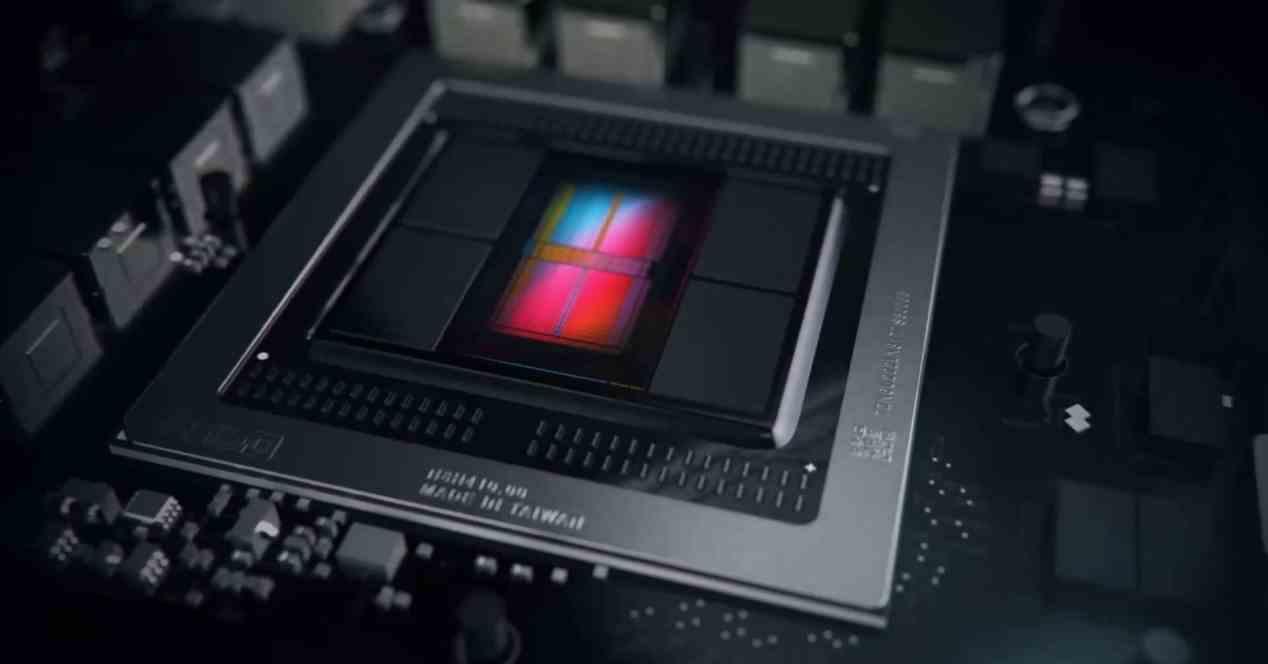Often a technology can look very good on paper, but ends up being a huge commercial failure due to the fact that what seemed like a great idea at the beginning leads to a series of problems that are not seen at first glance and appear during its development. . One such case is HBM2 memory, which several years ago promised to replace the GDDR5 memory for all time. Reality? GDDR6 is the most used in gaming graphics cards. What was to be its replacement has been relegated to the server market using so-called HPC GPUs.
Technically and on paper, if you ask any system architect they will tell you that HBM2 is a better type of memory than GDDR6. So how come there isn’t a single AMD RX 6000 or NVIDIA RTX 30 using it if it’s so good? That’s the question we want to answer with this comparison, and we’ll do it in a way that all readers can understand.
What are HBM memories and what advantages do they offer?
HBM memory is a type of RAM that has become popular in recent years in graphics hardware for data centers and servers. However, when it comes to PC graphics cards, they have disappeared from the market. Today, they are the best type of memory available for the following reasons:
- can reach the same bandwidths as GDDR6 and same GDDR6X.
- Its latency is lower than GDDR6 and GDDR6X. Which makes it useful for server processors with tens or even hundreds of cores. Especially those that are designed with specialized units for machine learning. In other words, the so-called artificial intelligence.
- Su Power consumption per transmitted bit is almost half compared to GDDR6. This is done to increase the number of interconnects, allowing them to operate at lower speeds and therefore lower voltage.
- Each memory chip is displayed horizontally across the board, in the case of the HBM2 you can have configurations of 4 or 8 chips, one above the other and therefore vertically. which means that the space they end up occupying is much less.

This is how HBM memory works
To achieve their high bandwidth but low power consumption, they need HBM memories use a large number of interconnect pinsnm The problem with this approach is that it would mean the chip size would increase to interconnect each pin with the corresponding memory chip. And not only from the graphics chip, but also from the memory. The solution? Well, what you’re doing is sending out the wiring and using an extra room. The so-called Interposer, which adds additional cost and manufacturing complexity.
For what the Interposer is an additional cost on the process and complicates the assembly of the new chip, increasing the potential number of assembly failures. Not only that, but because HBM memory chips are stacked, it’s not as simple as stacking on top of each other. In order for the chip at the top of the stack to communicate with the interposer, its wiring must pass vertically through the rest of the memory chips in the stack. that we call via silica or TSV.
To visualize it, imagine a building where water and electricity are on the ground floor and must be distributed to all floors. Well, the same thing happens in the case of HBM memory. This is why it is so expensive to manufacture and since price is an important value to consider in the consumer market. You then end up sacrificing the advantages of space and consumption, in exchange for lower costs.
Why is HBM memory not used in PC graphics cards?
So, with the question of price, we have to take into account that an ordinary user is going to look for the hardware that always gives him the best performance within his budget. the Advantages of HBM2
Let’s imagine that we have two identical graphics cards, with the same GPU and the same performance, however, one has more expensive memory than the other. What is happening? The manufacturer cannot sell a variation of the product which is as good as the standard product for the end user at a higher price if it does not add a significant benefit to the primary utility for which it is used. In other words, manufacturers stopped using HBM2 in their game graphics for a reason: profit margins.
What is GDDR6 memory and how does it compare to HBM2?
GDDR6 is the sixth generation of Dual Data Rate memory focused on its use for graphics cards. They differ from conventional RAM in that they sacrifice access latency, something that does not affect the graphics chip, in exchange for high bandwidth, which is essential when rendering graphics. In other words, we are dealing with a type of memory that is ideal for use in a GPU, but disastrous for a central processor. That’s why we don’t see any DIMMs with GDDR6 for our PC.
| Feature | HBM2 | GDDR6 | GDDR6X |
|---|---|---|---|
| tokens per unit | 4 and 8 | 1 | 1 |
| capacity per chip | 2 GB (up to 16 GB per disk) | 1 or 2 GB | 1 or 2 GB |
| Bus | 1024 bit | 32 bit | 32 bit |
| Channels | 8 (128 bits per channel) | 2 (16 bit per channel) | 2 (16 bit per channel) |
| Transfer speed | From 2Gbps to 2.4Gbps | 12 to 18 Gbit/s | 19 to 21 Gbit/s |
| Others | Requires Interpose | Up to 2 units sharing the bus | Up to 2 units sharing bus/PAM4 encoding |
GDDR6, Compared to its predecessors, this is a step forward, as each chip behaves like two independent chips, as each 16-bit data bus now has its own address/command bus. In other words, it is a dual channel memory and therefore can respond to two queries at the same time. The HBM2, on the other hand, has the advantage of having lower latency, which makes it ideal for server CPUs with dozens of cores, but not for a graphics card, and it has up to 8 channels of different memories, one for each chip. that we put on the stack.
The advantage of GDDR6 over HBM2 comes down to one thing, it is much cheaper and its widespread use helps. We don’t just see it in PC graphics cards, but also in video game consoles. If we were to compare the bulk of product sales by memory type, we would see that HBM’s percentage would be in the single digits.
The GDDR6X, a glimpse of the future?
With the appearance of the NVIDIA RTX 30, especially in the most powerful graphics cards of this range. We have seen a variant of the GDDR6 appear on the market which has been called GDDR6X. Its operation is based on the use of a type of encoding called PAM4where for each data pin instead of sending the values 0 or 1, the values 00, 01, 10 and 11 are sent via voltage changes.
In other words, it is a way to increase bandwidth without increasing the clock speed to alarming levels and therefore reduce consumption. which allowed speeds up to 21 Gbps and enable full transfer speeds previously only possible with a 4-stack or 4096-bit HBM configuration. Yes, with some really high consumption. The story is again the same. Although GDDR6X is less efficient than any other HBM memory, but again it is much cheaper. Which caused HBM to say goodbye to high-end GPUs.
New PCIe Gen 5 slot is the nail in the coffin
We told you before that one of the strengths of HBM memory compared to GDDR6 memory is its lower power consumption. Which is an advantage when you’re getting dangerously close to the power limits of the graphics card’s power connector. Let’s not forget that for years the 350 W consumption was the limit. So more power efficient memory like HBM made a lot more sense.
PCI Express 5.0 graphics cards will bring with them a new connector for power up to 600 W. Which eliminates the need for more efficient memory. In other words: HBM2 memory becomes even more useless in a gaming graphics card. Since then, one of the problems it was originally created for has disappeared. And yes, it would be much better for environmental reasons, a type of energy that consumes much less. However, that’s what the industry players have decided: to increase the consumption of the material.
Table of Contents











